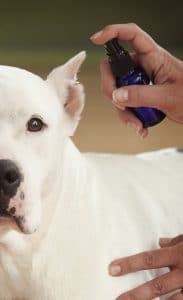Menu
Menu
close
A spray designed for canine ear conditions. Shake well, spray 1-3 pumps onto the ear flap area, and the area around the entrance to the ear canal, once to twice a day - or as instructed by your veterinarian. This product is not intended to be poured into the ear canal. Discontinue use if skin becomes red or irritated. Always consult with a qualified veterinarian for appropriate duration and response.
***This page contains additional information as well as Instructions for Use for this product. Please scroll down and select tabs to read more.***
**For many reasons, printed information and Instructions will not be provided with orders.**
Price range: $22.95 through $76.68
Canine Ear Spray is intended as a spray to be used with a variety of ear conditions in dogs. Essential oils contained within this product exhibit anti-parasitic, anti-fungal, anti-bacterial, anti-tumoral, and anti-inflammatory properties. In our veterinary hospital, the use of this spray has proven incredibly beneficial for dogs with chronic ear conditions, and especially those that are resistant to many traditional drugs and antibiotics. Many of our patients were near surgical removal of the ear canal (Total Ear Canal Ablation or TECA surgery) prior to starting on the Canine Ear Spray. In clinical use, we see great comfort with the use of the spray and also vast improvements in infection, swelling, and pigmentation. A major benefit to a spray such as this - is that is actually supports a healthy immune system, instead of shutting the immune system off - as in the case with steroid use.

There are many factors that may contribute to your dog's chronic, recurrent, or first time ear condition. Please read more about other changes you can make in your dog's lifestyle that will help you to combat chronic ear infections and allergies.
Ingredients: Fractionated Coconut Oil, Water, Grain Alcohol, Essential Oils of Copaiba (Copaifera officinalis) , Lavender (Lavendula angustifolia), Lemongrass (Cymbopogon flexuosus), Melaleuca alternifolia, Citronella (Cymbopogon nardus), Clove (Syzygium aromaticum), Helichrysum (H. italicum), Rosemary (Rosmarinus officinalis Verbenone Chemotype), Lemon (Citrus limon), Frankincense (Boswellia carterii)
Dogs: Shake well before each use. The product will separate and must be shaken prior to each and every use. Spray 1-3 pumps into the ear(s), once to twice a day. You are not trying to saturate the ear canal or drip the solution into the ear canal directly. Coating the outer surface of the ear and upper part of the exposed ear canal, will result in the "traveling" of this solution to deeper parts of the ear. Monitor the ear tissues for any signs of irritation, and stop use if additional redness or irritation is noted. Generally this recipe is used for 2 weeks or longer. Work with your veterinarian to determine frequency and length of use, based on response and recheck ear smear results.
Alternatively, for dogs who do not like the product to be sprayed into the ear, you can use a dropper or pipette (pipettes are for sale under accessories) to put Canine Ear Spray liquid into the ear - AFTER it is thoroughly shaken and milky in appearance. You may also place the liquid (after shaking) onto fingers and wipe into the ear gently. The use of cotton pads, balls, and swabs is generally not recommended as they absorb a lot of the product, and they are also quite abrasive to delicate ears.
This recipe has been used long term, for several months at a time or more when needed. However, if irritation occurs, please discontinue use. Although Canine Ear Spray rarely creates irritations, if it does occur, placing Fractionated Coconut Oil into the ear and onto any irritated surfaces will help decrease any issues. Fractionated Coconut Oil is safe for use in the ear - however we do not recommend filling the entire ear canal with it. Alternatively, Plain French Green Clay can be dusted onto areas that have become more irritated. And for animals who do not tolerate any liquids being sprayed or dropped into their ears, or their skin is incredibly irritated or ulcerated - the use of YeastyBeasty French Green Clay or Skin Spray French Green Clay is recommended.
 Can Canine Ear Spray be used on cats?
Can Canine Ear Spray be used on cats?I get this question often. So, let's address it. First off, most cats are really not going to appreciate a spray into the ear. So, even if the solution was ideal for a cat - they probably wouldn't let you spray them in the ear more than once or twice without hiding from you. And we all know how well cats can disappear when they want to! But, most importantly, cats should not be experiencing ear infections in the same way that dogs do. I truly find that if the cat does not have ear mites - then the suspected "ear infection" is really a dietary problem. Feeding grains, certain proteins, and my list of corn, soy, wheat, egg, or dairy products...can really cause nasty black, itchy, and red ears for cats. Diet should always be addressed first, unless the cat is known to have ear mites. More will be coming soon on ear mites - but you can read some on the subject by CLICKING HERE.
READ MORE ABOUT EAR INFECTIONS HERE.
What about other animals? Many animals do not have the ear conditions that dogs do. However, we have used Canine Ear Spray for human ears, on the plaques of horse ears, and even on various skin conditions. The liquid is quite safe, it is just that the delivery system of a spray, may or may not work out for various needs or species. In general this product was made with dogs in mind, however there are times we will consider using it for a variety of other species and conditions.Print
Only logged in customers who have purchased this product may leave a review.
Destiny White (verified owner) –
WOW this stuff WORKS!